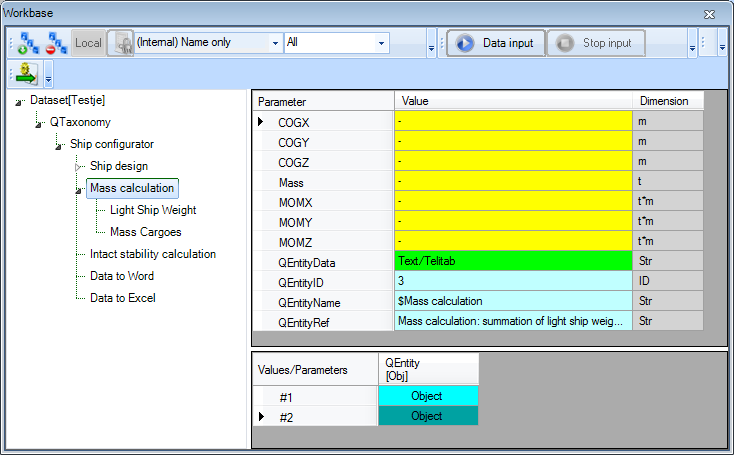Page History
...
1 Total mass calculation
Now that the whole ship itself is in place, you are ready for some analysis functionality.
...
- Include the following parameters in entity
Mass calculation:Mass,COGX,COGY,COGZ,MOMX,MOMY,MOMZandQEntityRef. - Create the following relations in the Knowledge Browser and connect them to the pertaining parameters in entity
Mass calculation.
...
- .
Mass = SUM(@QEntity, 1, @Mass)
...
(The result will be the summation of all parameters
...
Mass
...
of the
...
entities one level below.)
COGX = MOMX/Mass
COGY = MOMY/Mass
COGZ = MOMZ/Mass
MOMX = SUM(@QEntity, 1, @MOMX)
MOMY = SUM(@QEntity, 1, @MOMY)
MOMZ = SUM(@QEntity, 1, @MOMZ)
- To show computed values during a dialogue write “@SHOW” behind “QEntityData”set attribute @SHOW on
QEntityData. - Assign the following text for “QEntityRef”; “Mass to
QEntityRef:“Mass calculation: summation of light ship weight and total cargo weight”
Figure 79: Entity "Mass calculation"
2.4.1 Light Ship Weight
First include the Entities:
Mass Hull | child of “Light Ship Weight” | Entity Type: singular obligatory |
Mass Decks | child of “Light Ship Weight” | Entity Type: singular obligatory |
Mass Bulkheads | child of “Light Ship Weight” | Entity Type: singular obligatory |
- Include the following parameters in Entity “Light Ship Weight“: “Mass”, “COGX”, “COGY”, “COGZ”, “MOMX”, “MOMY”, “MOMZ “and “QEntityData”.
...
- weight”.
Please note, that you just created 'normal' relations and connected these to the parameters in the entity, because these are going to be used in several Mass entities.
2 Light Ship Weight
- Include the entities:
Mass Hull,Mass DecksandMass Bulkheadsas children ofLight Ship Weight. All three are singular obligatory. - Include the following parameters in entity
Light Ship Weight:Mass,COGX,COGY,COGZ,MOMX,MOMY, andMOMZ. - Connect the same relations as above from the Knowledge Browser to the pertaining parameters in
...
- Mass = SUM(@QEntity, 1, @Mass) ; The result will be the summation of all parameters “Mass” of the Entities one level below.
- COGX = MOMX/Mass
- COGY = MOMY/Mass
- COGZ = MOMZ/Mass
- MOMX = SUM(@QEntity, 1, @MOMX);
- MOMY = SUM(@QEntity, 1, @MOMY)
- MOMZ = SUM(@QEntity, 1, @MOMZ)entity
Light Ship Weight. - To show computed values during a dialogue write “@SHOW” behind “QEntityData”set attribute @SHOW on
QEntityData.
2.4.1.1 Mass Hull
Create the following parameter in the Knowledge Browser.
Parameter name | Dimension | Determined by | Reference | In Class |
| [t/m^3] | USR: User or system/equation | Weight factor per volume | Mass calculation |
- Include the following parameters in Entity “following parameters in entity
Mass Hull“: “Mass”, “COGX”, “COGY”, “COGZ”, “MOMX”, “MOMY”, “MOMZ“, “Volume”, “ andWeight_volume_factor” and “QEntityData”. - Create the following relations in
...
- entity
Mass Hull(here, 12 is the entity ID ofMain Dimensions, change this for your case):
COGX = (
...
...
12).Lpp)*0
...
.5 (assume the centre of gravity of the hull in X direction half of the ship length
...
)
COGY = 0
...
(amidships)
COGZ = (
...
...
12).Dm)*0.45
...
(assume the centre of gravity of the hull in Z direction at 45 % of the moulded depth
...
)
MOMX = COGX*Mass
MOMY = COGY*Mass
MOMZ = COGZ*Mass
- To show computed values during a dialogue write “@SHOW” behind “QEntityData”.set attribute @SHOW on
QEntityData. - Make parameter Volume in entity Mass use local properties ("Instantiate").
- Create the following relation in entity
Mass Hull(here, 13 is the entity ID ofHydrostatics, change this for your case): - Volume = ENTITY#(xx13).Volume
- ; for xx fill in the value of QEntityID of Entity ”Hydrostatics”. Make sure to instantiate this parameter and remove @MODIFY because you do not want to allow this at this position.
- Mass = Weight_volume_factor*Volume
...


